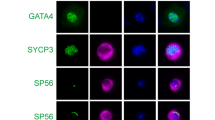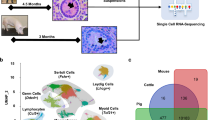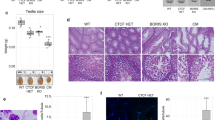Abstract
Ca2+/calmodulin-dependent protein kinase IV (Camk4; also known as CaMKIV), a multifunctional serine/threonine protein kinase with limited tissue distribution, has been implicated in transcriptional regulation in lymphocytes, neurons and male germ cells1,2,3,4,5,6. In the mouse testis, however, Camk4 is expressed in spermatids and associated with chromatin and nuclear matrix7. Elongating spermatids are not transcriptionally active8, raising the possibility that Camk4 has a novel function in male germ cells. To investigate the role of Camk4 in spermatogenesis, we have generated mice with a targeted deletion of the gene Camk4. Male Camk4−/− mice are infertile with impairment of spermiogenesis in late elongating spermatids. The sequential deposition of sperm basic nuclear proteins on chromatin is disrupted, with a specific loss of protamine-2 and prolonged retention of transition protein-2 (Tnp2) in step-15 spermatids. Protamine-2 is phosphorylated by Camk4 in vitro, implicating a connection between Camk4 signalling and the exchange of basic nuclear proteins in mammalian male germ cells. Defects in protamine-2 have been identified in sperm of infertile men, suggesting that our results may have clinical implications for the understanding of human male infertility.
This is a preview of subscription content, access via your institution
Access options
Subscribe to this journal
Receive 12 print issues and online access
$209.00 per year
only $17.42 per issue
Buy this article
- Purchase on Springer Link
- Instant access to full article PDF
Prices may be subject to local taxes which are calculated during checkout





Similar content being viewed by others
References
Westphal, R.S., Anderson, K.A., Means, A.R. & Wadzinski, B.E. A signaling complex of Ca2+-calmodulin-dependent protein kinase IV and protein phosphatase 2A. Science 280, 1258–1261 (1998).
Enslen, H. et al. Characterization of Ca2+/calmodulin-dependent protein kinase IV. Role in transcriptional regulation. J. Biol. Chem. 269, 15520–15527 (1994).
Chatila, T., Anderson, K.A., Ho, N. & Means, A.R. A unique phosphorylation-dependent mechanism for the activation of Ca2+/calmodulin-dependent protein kinase type IV/GR. J. Biol. Chem. 271, 21542–21548 (1996).
Sun, P., Enslen, H., Myung, P.S. & Maurer, R.A. Differential activation of CREB by Ca2+/calmodulin-dependent protein kinases type II and type IV involves phosphorylation of a site that negatively regulates activity. Genes Dev. 8, 2527–2539 (1994).
Anderson, K.A., Ribar, T.J., Illario, M. & Means, A.R. Defective survival and activation of thymocytes in transgenic mice expressing a catalytically inactive form of Ca2+/calmodulin-dependent protein kinase IV. Mol. Endocrinol. 11, 725–737 (1997).
Bito, H., Deisseroth, K. & Tsien, R.W. CREB phosphorylation and dephosphorylation: a Ca(2+)- and stimulus duration-dependent switch for hippocampal gene expression. Cell 87, 1203–1214 (1996).
Wu, J.Y. & Means, A.R. Ca2+/calmodulin-dependent protein kinase IV is expressed in spermatids and targeted to chromatin and the nuclear matrix. J. Biol. Chem. 275, 7994–7999 (2000).
Soderstrom, K.O. & Parvinen, M. RNA synthesis in different stages of rat seminiferous epithelial cycle. Mol. Cell. Endocrinol. 5, 181–199 (1976).
Sun, Z., Sassone-Corsi, P. & Means, A.R. Calspermin gene transcription is regulated by two cyclic AMP response elements contained in an alternative promoter in the calmodulin kinase IV gene. Mol. Cell. Biol. 15, 561–571 (1995).
Blendy, J.A., Kaestner, K.H., Weinbauer, G.F., Nieschlag, E. & Schutz, G. Severe impairment of spermatogenesis in mice lacking the CREM gene. Nature 380, 162–165 (1996).
Nantel, F. et al. Spermiogenesis deficiency and germ-cell apoptosis in CREM-mutant mice. Nature 380, 159–162 (1996).
Russell, L.D., Ettlin, R.A., Sinha Hikim, A.P. & Clegg, E.D. Histological and Histopathological Evaluation of the Testis 119–161 (Cache River Press, Clearwater, Florida, 1990).
Meistrich, M.L. Histone and basic nuclear protein transitions in mammalian spermatogenesis. in Histones and Other Basic Nuclear Proteins (eds Hnilica, L.S., Stein, G.S. & Stein, J.L.) 165–182 (CRC Press, Boca Raton, Florida, 1989).
Lee, K., Haugen, H.S., Clegg, C.H. & Braun, R.E. Premature translation of protamine 1 mRNA causes precocious nuclear condensation and arrests spermatid differentiation in mice. Proc. Natl Acad. Sci. USA 92, 12451–12455 (1995).
Zhong, J., Peters, A.H., Lee, K. & Braun, R.E. A double-stranded RNA binding protein required for activation of repressed messages in mammalian germ cells. Nature Genet. 22, 171–174 (1999).
Yelick, P.C. et al. Mouse protamine 2 is synthesized as a precursor whereas mouse protamine 1 is not. Mol. Cell. Biol. 7, 2173–2179 (1987).
Green, G.R., Balhorn, R., Poccia, D.L. & Hecht, N.B. Synthesis and processing of mammalian protamines and transition proteins. Mol. Reprod. Dev. 37, 255–263 (1994).
Pirhonen, A., Linnala-Kankkunen, A. & Menpaa, P.H. P2 protamines are phosphorylated in vitro by protein kinase C, whereas P1 protamines prefer cAMP-dependent protein kinase. A comparative study of five mammalian species. Eur. J. Biochem. 223, 165–169 (1994).
Elsevier, S.M., Noiran, J. & Carre-Eusebe, D. Processing of the precursor of protamine P2 in mouse. Identification of intermediates by their insolubility in the presence of sodium dodecyl sulfate. Eur. J. Biochem. 196, 167–175 (1991).
Xu, X., Toselli, P.A., Russell, L.D. & Seldin, D.C. Globozoospermia in mice lacking the casein kinase II a′ catalytic subunit. Nature Genet. 23, 118–121 (1999).
Bench, G., Corzett, M.H., De Yebra, L., Oliva, R. & Balhorn, R. Protein and DNA contents in sperm from an infertile human male possessing protamine defects that vary over time. Mol. Reprod. Dev. 50, 345–353 (1998).
de Yebra, L. et al. Detection of P2 precursors in the sperm cells of infertile patients who have reduced protamine P2 levels. Fertil. Steril. 69, 755–759 (1998).
Kennedy, B.P. & Davies, P.L. Phosphorylation of a group of high molecular weight basic nuclear proteins during spermatogenesis in the winter flounder. J. Biol. Chem. 256, 9254–9259 (1981).
Louie, A.J. & Dixon, G.H. Kinetics of enzymatic modification of the protamines and a proposal for their binding to chromatin. J. Biol. Chem. 247, 7962–7968 (1972).
Edelman, A.M. et al. Multiple Ca(2+)-calmodulin-dependent protein kinase kinases from rat brain. Purification, regulation by Ca(2+)-calmodulin, and partial amino acid sequence. J. Biol. Chem. 271, 10806–10810 (1996).
Tokumitsu, H., Enslen, H. & Soderling, T.R. Characterization of a Ca2+/calmodulin-dependent protein kinase cascade. Molecular cloning and expression of calcium/calmodulin-dependent protein kinase kinase. J. Biol. Chem. 270, 19320–19324 (1995).
Reyes, J.C., Muchardt, C. & Yaniv, M. Components of the human SWI/SNF complex are enriched in active chromatin and are associated with the nuclear matrix. J. Cell Biol. 137, 263–274 (1997).
Acknowledgements
We thank R. Balhorn for the protamine antibodies; S. Kistler for the Tnp2 antibody; C. Bock for the generation of the mutant mice; A. Nagy, R. Nagy and W. Abramow-Newerly for the use of R1 ES cells; and X.F. Wang, Y. Zhuang, E. Linney and E.M. Eddy for helpful discussions. This work was supported by an N.I.H. Medical Scientist Training Program award to J.Y.W. and N.I.H. grant HD07503 to A.R.M.
Author information
Authors and Affiliations
Corresponding author
Rights and permissions
About this article
Cite this article
Wu, J., Ribar, T., Cummings, D. et al. Spermiogenesis and exchange of basic nuclear proteins are impaired in male germ cells lacking Camk4. Nat Genet 25, 448–452 (2000). https://doi.org/10.1038/78153
Received:
Accepted:
Issue Date:
DOI: https://doi.org/10.1038/78153
This article is cited by
-
Epigenetic markers in the embryonal germ cell development and spermatogenesis
Basic and Clinical Andrology (2023)
-
Identification, characterization and functional analysis of gonadal long noncoding RNAs in a protogynous hermaphroditic teleost fish, the ricefield eel (Monopterus albus)
BMC Genomics (2022)
-
CAMKK2-CAMK4 signaling regulates transferrin trafficking, turnover, and iron homeostasis
Cell Communication and Signaling (2020)
-
Epigenetic changes in mammalian gametes throughout their lifetime: the four seasons metaphor
Chromosoma (2019)
-
A report of nine cases and review of the literature of infertile men carrying balanced translocations involving chromosome 5
Molecular Cytogenetics (2018)



